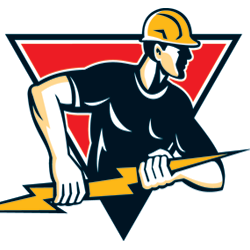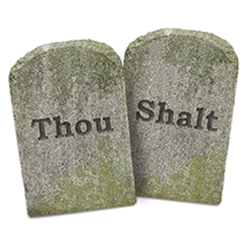 |
 Candy Adams,
Candy Adams,
CTSM, CME,
CEM, CMP, CMM,
is an independent exhibit-management
consultant, trainer, speaker, writer, and an Exhibitor conference
faculty member.
CandyAdams
@BoothMom.com
|
| |
 s an exhibit professional, you've undoubtedly experienced your fair share of sleep-inducing in-booth sales presentations. You know, the earnest but dreadfully boring Joe Boothstaffer, standing in his exhibit in front of a PowerPoint slide, lecturing to a few uninterested attendees who have merely found a chair to rest their aching feet. You've also probably seen
the opposite: standing-room-only crowds blocking the aisles. Cheers. Laughter. Enthusiastic applause. s an exhibit professional, you've undoubtedly experienced your fair share of sleep-inducing in-booth sales presentations. You know, the earnest but dreadfully boring Joe Boothstaffer, standing in his exhibit in front of a PowerPoint slide, lecturing to a few uninterested attendees who have merely found a chair to rest their aching feet. You've also probably seen
the opposite: standing-room-only crowds blocking the aisles. Cheers. Laughter. Enthusiastic applause.
If you're going to host an in-booth presentation, you'd likely rather be in the SRO boat than play host to a swath of weary attendees who are more interested in taking a load off than paying attention to your presenter. So before you add an in-booth presentation to your exhibit program, consider the following advice.
Have Something to Say
Before you start planning your presentation, ask yourself whether you have anything interesting to say. A boring presentation about a product you launched three years ago might do more harm than good, positioning you and your brand as dated and irrelevant. But if you have new products, new-and-improved features on existing products, a new marketing or branding campaign, or anything, well, new, then a presentation might be a good idea.
You might also want to consider an in-booth presentation if your primary objective at the show is to dispel myths about your company or products, demonstrate a particularly complex technology, or educate attendees about who you are, what you do, and why they should buy your products. A well-crafted presentation can not only help you achieve these goals; the one-to-many format of a presentation can help you reach a broader swath of booth visitors and passersby than you would be able to reach if you relied solely on one-on-one conversations.
Once you've identified that you do, in fact, have something interesting to say to attendees, ask yourself if that message is relevant to a broad swath of attendees at the show. If the bulk of the show's attendees represent your target audience, and you're looking to announce a new product, for example, then a presentation makes perfect sense. But if you're only targeting a tiny portion of the attendee population, a formal presentation might be overkill.
Craft Your Key Message
Next, you need to craft your message. Ask yourself, "What information made our current customers buy from us?" Attendees walking the show floor are looking for products and services that will save them time or money, or make their jobs or lives easier. The most effective presentations demonstrate how a company or its offerings will help attendees cut costs, increase efficiency, or avoid hassles. So focus your presentation on the benefits of your product that will help attendees achieve those things, and your message is far more likely to resonate.
Obviously, you don't have to limit yourself to one presentation. Some of the most successful in-booth presentation models alternate between general company/product overviews and varied product- or application-specific presentations. In fact, I've seen exhibitors post schedules of rotating presentation topics, including everything from brief product-launch presentations to lengthier panel- or session-style presentations addressing customers' pain points or providing a case study of how a client employed the exhibitor's products to overcome a particular challenge.
But remember, when it comes to in-booth presentations, it's generally best to keep things concise. Just as graphics with too much information are ineffective, endless presentations that drone on and on won't retain attendees' interest either. My rule of thumb: A presentation should last no more than seven minutes.
Rehearse, Rehearse, Rehearse
Before you get too far along in your presentation planning, you'll need to decide who is going to actually serve as your in-booth presenter. That person might be one of your booth staffers, a product specialist, a business partner, a current customer (or panel of existing customers), actors or professional entertainers, or a professional presenter.
If you select someone unaccustomed to presenting at trade shows, such as a member of your company's research-and-development team, it is essential that he or she rehearse. And I don't mean a couple of pre-show run-throughs after arriving in the show's host city. He or she needs to practice the presentation and memorize the script long before leaving for the show. Then, run a pre-show rehearsal in the exhibit using all audiovisual and presentation tools. This on-site run-through is a chance for your presenter to polish his or her performance, get used to the microphone, and fix any problems with your AV equipment. But if this is the first time your presenter has seen the script, you're begging for disaster.
You can find talent that specializes in trade show presentations through a trade show marketing agency or a talent agency. Most big cities have several talent agencies, and there's usually an official agency listed in the show manual.
Set the Stage
Your presentation area should be highly visible to aisle traffic and inviting enough to draw attendees in. Use a high-quality display and sound system so your presentation looks and sounds professional and so attendees can see and hear clearly from a distance. Remember that the industry standard for the maximum decibel (dB) level when measured from the center of the aisle in front of your presentation is 85 to 90 dBs.
For brief presentations, you don't have to provide plush seating - just something to let your audience take a load off for a few minutes. You can rent standard, general-contractor-issued stacking chairs, benches, or horizontal "bum bars" to lean against. Whatever you choose, break up your rows of seating with aisles to allow easy access and egress. Nobody wants to be stuck in the middle of a long row of seats and have to crawl over other audience members to get to an empty chair.
You'll also need to decide how to handle those attendees who stand behind your seating area and spill into the aisle. The booth-space contract you signed probably has a clause that prohibits you from using the aisle space outside your exhibit. This is referred to as a "confines of booth" clause, and states whatever you do has to be within your rented booth space and not in common areas including the aisles. Show management understands that exhibitors can't control aisle traffic, but if your presentations continue to create crowds that block the aisle traffic to other exhibitors, they may mandate that you get security personnel to keep the crowd moving and not blocking the aisles.
Time it Right
When should you hold your presentations and how frequently? One consideration is your location on the show floor. It generally takes longer for attendees to get to the back and rear corners of the exhibit hall, so if your exhibit isn't front and center, you may want to delay your first presentation of the day until at least a half hour after the show opens.
And to avoid competing with surrounding exhibits, contact show management to get the names of your neighbors so you can coordinate the times of your presentations. It generally works out well if neighboring exhibitors agree on which one will present on the hour and half hour with any others presenting on the quarter and three-quarters hour. You can even announce to the audience that "Our neighbor is getting ready to start a presentation on Topic X in just a few minutes" to cooperatively drive traffic between your presentations.
Promote Your Presentation
Many companies spend time and money to create presentations but fail to promote them. Then they wonder why they're not generating the booth traffic they'd like.
Before the show, send or e-mail invitations to prospective attendees with a schedule of your presentation topics. Advertise your presentations on your company's Web site, and if you plan on distributing gifts to presentation attendees, advertise those as well.
Inform attendees walking the aisles of when your next presentation will begin by using a programmable ticker-tape-type display or clock that shows presentation start times. You might also want to add the length of the presentation and the topic.
If you have multiple topics and presenters, provide a pocket-sized schedule for attendees. You can also post announcements on Twitter so those following you at the show can plan to attend the presentations that most appeal to them.
Don't Forget to Measure
All of your meticulous planning can be for naught if you don't have a method to collect, manage, measure, and evaluate information from presentation attendees. Use either an electronic badge reader to capture demographic information or manual lead forms on clipboards with pens (pencil lead doesn't reproduce well on a copier if you need to make extra copies to distribute to your sales staff). Make sure you have sufficient exhibit staff available to monitor the audience's buying signals during the presentation (nodding as points are being made or rhetorical questions are asked often indicates the attendee is engaged and interested in what your presenter is saying) and to speak with prospects immediately after each presentation is over.
Set quantitative goals for both the number of presentation attendees and the number of qualified leads among that group. You can gather this data through your lead forms, audience-response systems, and notes from conversations between staff members and prospects. You can also use crowd gatherers to administer exit surveys between presentations to record attendee feedback, such as whether the presentation triggered
a change in perception of your
company or its products/services.
Don't forget to thank attendees for taking time out of their busy show schedule to attend your presentation. Whether it's a sincere, verbal "Thank you" or a token gift, make sure your audience knows it's appreciated.e
|





 s an exhibit professional, you've undoubtedly experienced your fair share of sleep-inducing in-booth sales presentations. You know, the earnest but dreadfully boring Joe Boothstaffer, standing in his exhibit in front of a PowerPoint slide, lecturing to a few uninterested attendees who have merely found a chair to rest their aching feet. You've also probably seen
the opposite: standing-room-only crowds blocking the aisles. Cheers. Laughter. Enthusiastic applause.
s an exhibit professional, you've undoubtedly experienced your fair share of sleep-inducing in-booth sales presentations. You know, the earnest but dreadfully boring Joe Boothstaffer, standing in his exhibit in front of a PowerPoint slide, lecturing to a few uninterested attendees who have merely found a chair to rest their aching feet. You've also probably seen
the opposite: standing-room-only crowds blocking the aisles. Cheers. Laughter. Enthusiastic applause. 


